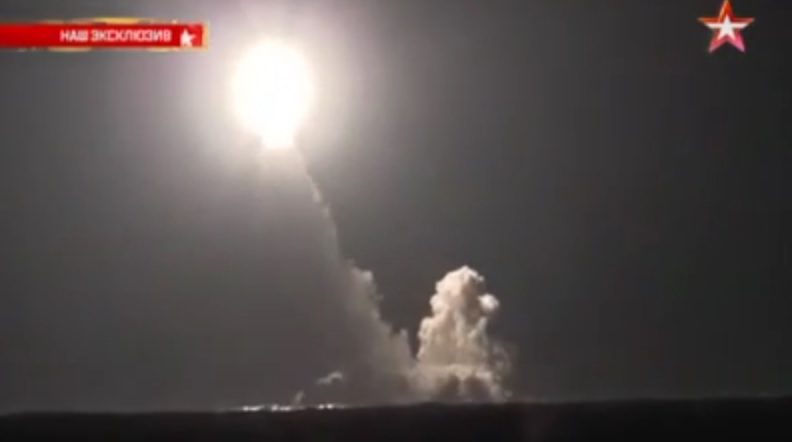The Russian Ministry of Defense posted a video clip showing two rapid-fire submarine launches of Bulava ICBMs that are capable of carrying multiple nuclear warheads taken some time this weekend.
The twin launches come days after the United States launched two submarine-based Trident II (D5) ICBMS off the California coast on Saturday night and Monday afternoon from the USS Kentucky. The first launch lit up Southern California and was seen in parts of Arizona and Nevada, startling people who thought it was the beginning of a nuclear war. Each missile is capable of carrying 14 nuclear warheads that can hit independent targets.

Image of U.S. submarine launch of ICBM, November 7, 2015, via Drudge Report.
The video clip was posted Saturday to Twitter by the Russian Ministry of Defense with a translated caption of, “# Video # For the first time multiple rocket launches two ICBMs “Bulava” from the board of ASMC “Vladimir Monomakh””
#Видео #Впервые Залповый ракетный пуск двух МБР "Булава" с борта АПРК "Владимир Мономах" pic.twitter.com/htjOpZGfQp
— Минобороны России (@mod_russia) November 14, 2015
The twenty-seven second video shows taken at night shows two missiles being successfully fired seconds apart following the same trajectory.
The Russians stated the launches took place in the White Sea.
“Submarine “Vladimir Monomakh” was first performed multiple rocket launches of ICBMs “# Mace” from the White Sea”
The test missile launches were reported in advance by Tass and also reported by the Barents Observer.
“Russia´s newest strategic nuclear-powered submarine “Vladimir Monomakh” will be launching two Bulava missiles during the coming days.
“If the launch is successful, or even in case only the launch mechanisms work normally, the submarine will be taken into active duty in the Russian Navy, a military source says to news agency TASS.
“According to plans, “Vladimir Monomakh” will be launching two Bulava missiles from underwater position in the White Sea to the Kura range on the Kamchatka peninsula no later than November 16. There will not be any more launches of the Bulava missile this year,” the source added.”
The Observer reported the Bulava missile, which can carry ten nuclear warheads, has had a troubled history but has improved in recent years with the introduction of the Borei class of submarines. The Vladimir Monomakh is the newest member of the Borei class and a successful test launch would put the sub on active duty in the Russian Navy added the Observer.
“The Bulava missile that the Borey-class submarines are constructed to be armed with, is a three-stages, 36 tons heavy submarine-launched ballistic missile capable of carrying ten nuclear warheads. Each submarine is armed with 16 missiles.
“Russia has been conducting tests with the Bulava missile since 2004. Until 2009, there were 6 failures in 13 flight tests and one failure during ground test, blamed mostly on substandard components. After a failure in December 2009, further tests were put on hold and a probe was conducted to find out the reasons for the failures. Testing was resumed one year later, and of the ten tests that have been conducted since then, only one has failed, according to Wikipedia.”
The Washington Free Beacon reported earlier this week on the Vladimir Monomakh.
“A product of the Rubin Marine Equipment Design Bureau, in all critical respects the Borei is a significant advance over the aging Typhoon and Delta IV class submarines it is replacing. At nearly 580 feet, the Borei is a large vessel, but the use of advanced technologies, including pump-jet propulsion from its nuclear reactor, also makes it substantially quieter than its relatively noisy predecessors, posing a challenge for U.S. Navy hunter-killer submarines.
“Each Borei will have a crew of 107, of which 55 will be officers. With the inclusion of research and development costs, the Borei will cost about $700 million per boat, far less than a comparable U.S. Ohio class submarine, the costs for which are about $2 billion.
…”The Borei class is designed to launch nuclear-armed ballistic missiles over intercontinental distances. The range of the 12 to 16 Bulava missiles carried onboard the Borei—each capable of carrying six to 10 warheads with maneuvering and other countermeasure capabilities—is estimated at about 5157 miles. The Borei also can defend itself by launching both conventional and nuclear armed torpedoes.
“With a service life expected to extend to at least 2040, the Borei will become a prominent fixture in the Russian military’s intercontinental attack capabilities…”
https://www.youtube.com/watch?v=s4FOU4yCvpk
A forty-five second long version of the twin launches was posted to YouTube on Saturday.

